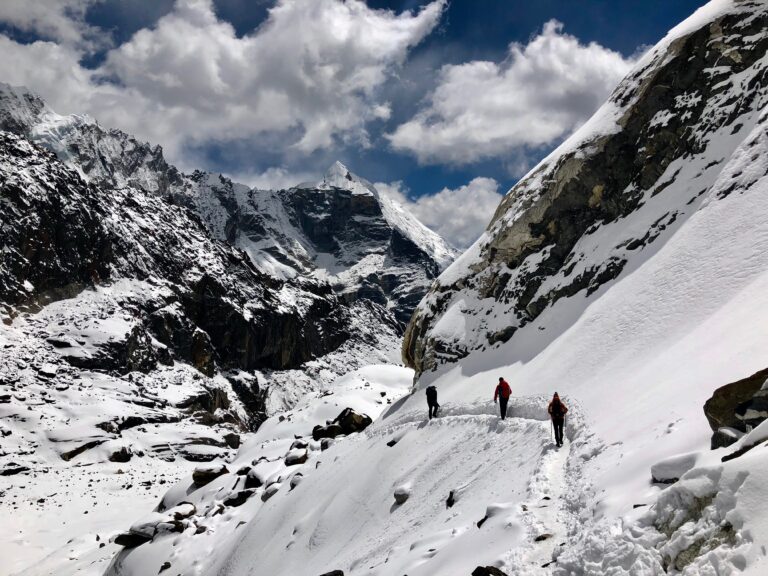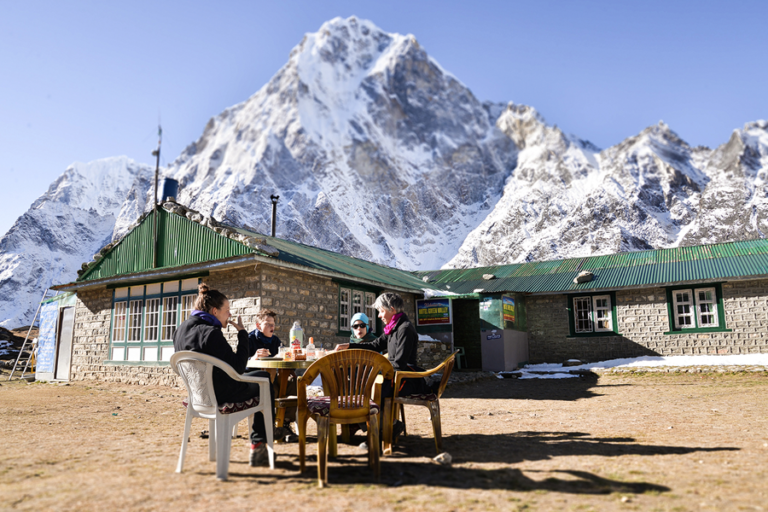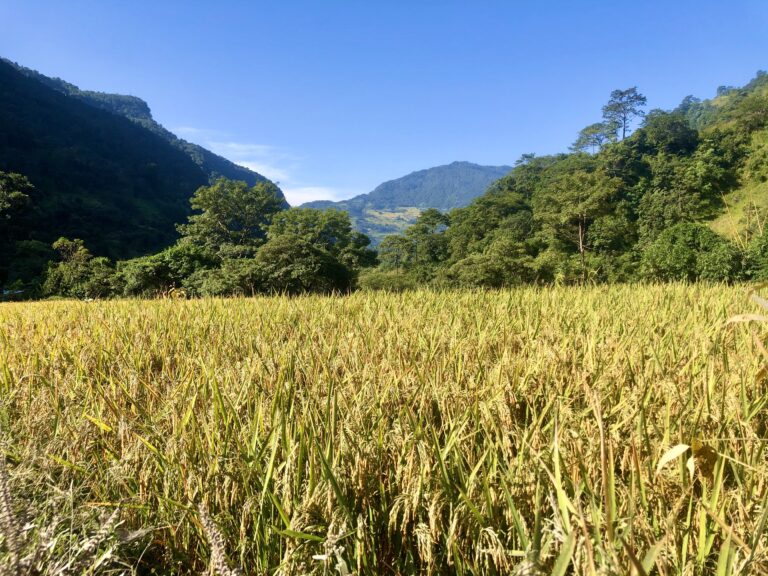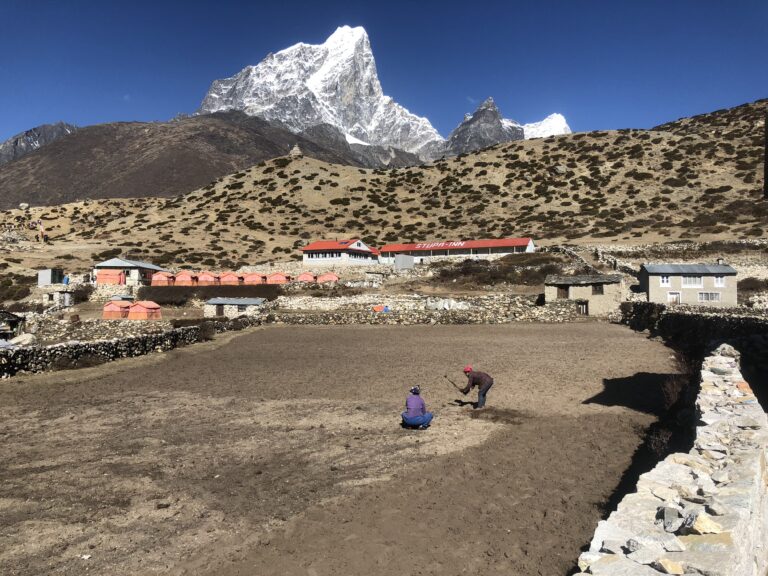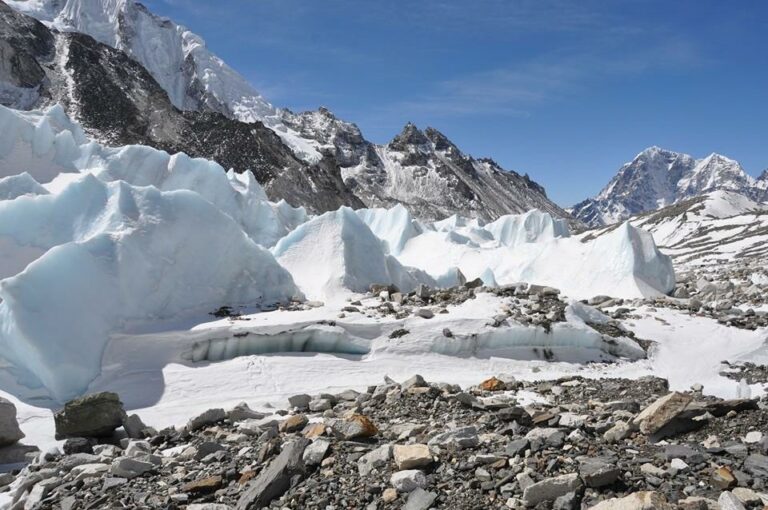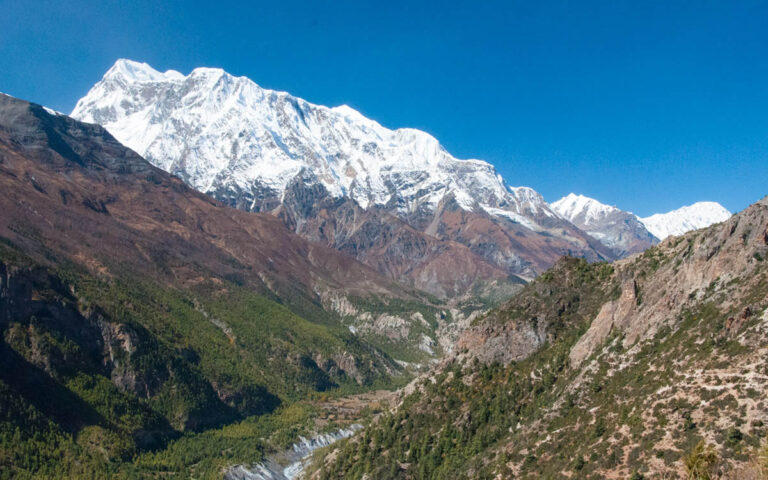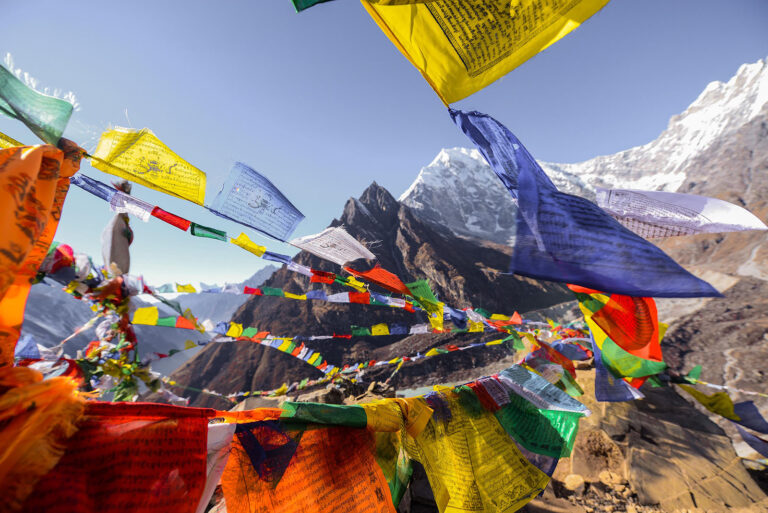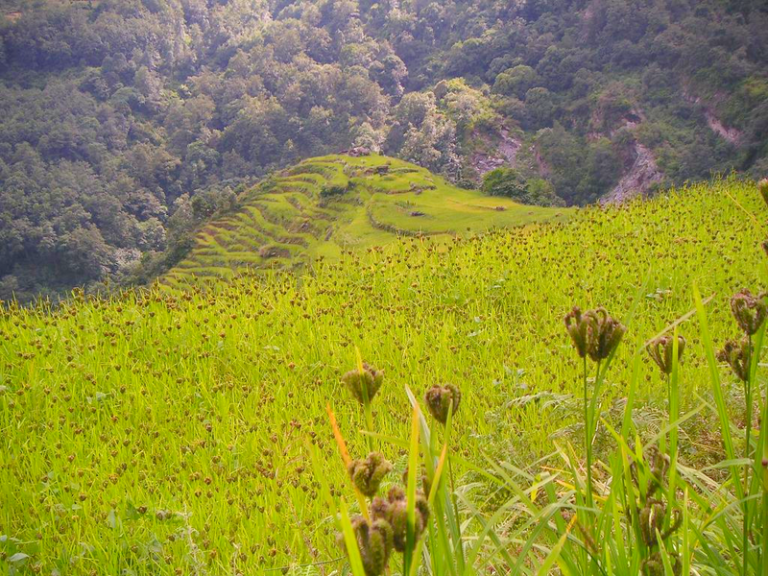Day 01 – Arrival in Kathmandu and escort to the hotel – At Kathmandu Tribhuvan International Airport on fresh arrival where you will be warmly received by our staff and then with an escort to your hotels in Thamel. After welcome tea your guide will brief for you about your trekking trip, programs, and required trekking gears.
Day 02 – Fly to Tumlingtar 45 minutes scenic flight – After breakfast, we will transfer to Kathmandu domestic airport then fly for Tumlingtar. The 45 minutes scenic flight commands us to see beautiful mountain ranges known as Langtang, Kanchenjunga, Makalu, Annapurna, Manaslu, and Everest. Tumlingtar is a beautiful town, located on a shelf above the Arun River. we’ll be in Tumlingtar later in the afternoon so after lunch, we will walk to the katle Bhanjyang village to see the beautiful valley and confluence of Arun and Savaya River. There are half dozens of good guesthouses in Tumlingtar and offers comfortable bedrooms and delicious Dall- Bhat with some pickles.
Day 03 – Trek to Katikeghat 840m.a.s.l)- 5 hours walk – Our first day of the walk start on the flat trail until Giddhe village and then the trail descends for 20 minutes to get the bank of the Arun River. we will follow the Arun River pass by Beteni and Chewa beshi village. Along the trail; we will have a beautiful paddy terraced field, fisherman, traditional wooden boat, gardens of Mangoes and Bananas, and subtropical forest of Shorea- Robusta. We will cross the Arun River by a long suspension bridge called Katike pul and we will set up our tent just bank of the Arun River.
Day 04 – Trek to Gothe Bazaar (800m.a.s.l) – 6 hours walk – we will climb gradually through the terraced field and subtropical forest to get our destination called Gothe Bazaar. Along the trail, we will pass half dozens of villages that are settled over the vertical land and inhabitants of Brahman, Chhetri, Biswakarma, Darnal, and Rai people. The main attraction of the would be the view of Arun River valley, admirable landscapes, and gardens of Rudraksha (Hindu’s holy beads).
Day 05 – Trek SalpaPhedi (2,415m.a.s.l) – 6 hours walk – Today; we have to climb almost 1600 meters to reach our harbor place. The trail passes through the paddy terraced field, Gardens of citrus fruits, bananas, Groves, and mangoes. along the trail; we can see beautiful landscapes, scary bamboo bridges, and streams where fishermen are fishing with traditional net and huck. The six hours of walk bring us to Salpaphedi which is sparsely populated by Rai and Sherpa people. There are half dozens of basic lodges and tea-shops in Salpaphedi. Stay one overnight in tented camp.
Day 06 – Trek to Guranse (3,075m.a.s.l) – 5 hours walk – The trail gently ascends from our camp of Salpa phedi to Salpa bhanjyang and passes through the lush forest of Bamboo, Rhododendron, Dampnepapaerius, and sandalwood. From Salpa bhanjyang the trail will be easier than before due to gradual up. The major attractions of the day would be the views of green landscapes, Nepali paper factories, very clean streams, traditional bamboo bridge, and Shepherd’s huts. Our camp Gurase is surrounded by the Rhododendron forest so if we are here in the Spring season we will be rewards by blooming flowers.
Day 07 – Trek to Guidel 1(,640m.a.s.l) via Salpa pass -7hours walk – Today we have to cross Salpa pass which is 3,349 meters high above the sea level. begins of the morning we will climb approximately three hours to reach Salpa pass that marks with a large Chhorten. From here, we will descend to the Hongu Khola through the hemlock and fir forest. The forest has been a homeland for Himalayan black bear, Deer, Himalayan Thar, Ghoral, Tigers, Monkeys, Red pandas, and many species of birds and butterflies so chirp sound of birds, barking deer and flying butterflies makes the joyful trip. The 4 hours of walk from Salpa pass bring us to Gudel village which is well-known as settlement of tribe a sub-castes of Rai people. Stay one overnight in Gudel village.
Day 08 – Trek to Khiraule (2,360m.a.s.l) – 5 hours walk – The trail from Gudel to Hinku River is very pleasant due to walk on the flat trail and passes through the agricultural terraced field. We will cross the Hinku river on a suspension bridge to reach Bung village which is one of the fertile areas of the region. The bung is inhabitant by the Kirat tribe and Sherpas are residing at higher altitudes. From here, we have to climb up about one hour to reach Khiraule where we going to sleep one overnight.
Day 09 – Trek to GhaiKharka (2,450m.a.s.l) – 6 hours walk – The trail gently ascend from Khiraule and passes through the lush forest of Pine, Sandalwood, Rhododendron, hemlock, and Oaks to get a top of the hill which is also known as Surke La (pass) 3,100 meters high above the sea level. The Surke La commands to see admirable landscapes view and green forest. From here; we will descend to the Gaikharka, a small far area where half dozens of tea-houses providing basic beds and meals for travelers.
Day 10 – Trek to Pangbung (2,670m.a.s.l) – 06 hours walk – After breakfast, we will walk on the descending trail to Hinku Khola and Dudh Koshi Khola with a wonderful view of River valley, waterfalls and green forest. After crossing a suspension bridge the trail ascends to the Kharte a small village of Sherpa people. From here the gradual and good winding trail lead towards a large village called Pangbung where we will set up our tent to sleep one overnight.
Day 11 – Trek to Paiya (2,800m.a.s.l) – 7 hours walk – From here onwards the air gets much cooler heading close to the Khumbu area. The trail leads us to a small climb on the wide meandering path through a mixed forest of oak, rhododendron, and the fragment Dhaphnebholua; the Nepalese paper plant, birdlife, including pheasant, is abundant along this section of the trail. The walk continues traversing the flank of the Khartedanda high above the river to a notch in the ridge, the Kharte La 3,880m, journey continues through a small village of Paiya 2,800m, a nice spot in the middle of the forest.
Day 12 – Trek to Phakding (2,650m.a.s.l) – 7 hours walk – We will head towards Phakding village pass by several villages called Surke, Muse, Chheplung, Chauri Kharka, Thado Koshi and Ghat village. Along the trail, we will see the deep gorge of Dudh Koshi River, watermill, hundreds of stupa, monasteries, prayer wheels, mani walls, and admirable view of Konde and Kusum Kangaru peak. There are more than 30 guesthouses in Phakding village and they provide delicious meals and comfortable bedrooms.
Day 13 – Trek to Namche bazaar ( 3440 m.a.s.l.)- 5 hours walk – Today we follow the trail to Namche Bazaar. We will enter Sagarmatha National Park. We will then cross the confluence of the Dudh Kosi and the Bhote Kosi on a high suspension bridge and then climb steeply for about two hours up ‘Namche Hill’ to reach Namche Bazaar. This is a prosperous trading town and the capital of the Khumbu Region. Many Tibetans cross the nearby border to trade their wares and the local market is a fascinating spectacle. This is a good place to buy genuine Tibetan artifacts. Just across the valley to the east stand the peaks of Thamserku and Kangtega, both very impressive mountains. We will spend three nights here giving you excellent acclimatization on route to Lobuche peak.
Day 14 – Acclimatization day sight trip to Everest viewpoint and exploration of Khumjung village – we will spend two nights in Namche Bazaar to do acclimatization which that allow our bodies to become acclimatized better to altitudes above Namche Bazaar. On the first morning, we will hike up to Everest viewpoint which is located just top of the Namche Bazaar and commands to see the panoramic view of Thamserku, Amaadablam, Iceland peak, Taboche peak, Nuptse, Everest and it’s beautiful ranges. After hot drinks in Everest’s viewpoint, we will head towards Khumjung village which a beautiful valley and settlement of Sherpa people. we will explore a beautiful monastery called Khumjung monastery where also can be seen skull of Yeti. after the exploration of Khumjung village, we will return to Namche Bazaar and sleep one overnight in the same guesthouse.
Day 15 – Trek to Tengboche (3900 m.a.s.l)- 5 hours walk – From Namche, the well-worn Everest trail contours around the side of the valley, high above the Dudh Kosi. As we follow the path, we will get our first really good views of the great peaks of the Khumbu: Everest, Lhotse, Nuptse, and Ama Dablam. Passing by Sanasa, Phungi tanga villages, half dozen tea shops, we will cross the Dudh Kosi River and make a steep climb to Tengboche, home of an impressive and recently rebuilt monastery. We have enough time to look around the Tengboche monastery and have a cake at the bakery.
Day 16 – Trek to Dingboche (4415 m.a.s.l)- 6 hours walk – The trail until the bottom of the Pangboche is Shaded by rhododendron trees, the trail crosses an airy suspension bridge just beyond Deboche. An hour’s walking from Tengboche will bring us to Pangboche, an excellent viewpoint for Ama Dablam which means (Garland of Mother) in Sherpa language. From here; The trail ascends gradually to Somare village then we will turn up the Imja valley to get Dingboche. There are numerous guesthouses in Dingboche which provides delicious meals and comfortable bedroom with warm Sherpa hospitality.
Day 17- Acclimatization day in Dingboche – Dingboche is a good location to do acclimatization. There are two viewpoints called Dingboche viewpoint and Chhukung-Ri. Both viewpoints require 3 to 4 hours and give us some of the best views of Island peak, Lhotse, Makalu. You will see Cho Oyu the world’s 6th highest mountain and you will be treated to some of the best views of Ama Dablam.
Day 18 – Trek to Lobuche (4920 m.a.s.l) – 4 hours walk – The trail gently ascends from the yard of the guesthouse and half an 30 minutes of climb appear a beautiful stupa and then we take a gradual up trail above the Pheriche village. one and a had hours walk bring us to Thukla where we will stop to have our lunch. From here, we will climb approximately one hour to get a hilltop that offers to see the magnificent view of Ama Dablam, Thamserku, Lobuche peak, Iceland peak, Taboche peak, Cholatse peak and awesome view of Pheriche village valley to southwards. We will have plenty of time so we will spend the afternoon relaxing and continuing the process of slow acclimatization.
Day 19 – Trek to Gorak Shep (5180 m.a.s.l) – 3 hours walk – After 3 hours of walk bring us to Gorak Shep which is the last available guesthouse in the Everest region and surrounded by numerous of snow-capped peaks and mountains including Mount Everest. We can reach in Gorak Shep at lunchtime so it is possible to explore Everest base camp which may take about 3 hours for a round trip. Everest base camp offers to see huge Khumbu glaciers, glacial lakes, and the grand views of Mount Everest, Nuptse, Lhotse, Lobuche, Pumori, and their neighboring peaks and glaciers.
Day 20 – Sight trip to Kalapathar(5645m.a.s.l) and return to Pheriche village – Early in the morning, we will climb up to Kalapathar to see the sunrise on the background of white mountains. The climb up to Kala Pathar takes between two to two and a half hours and will be a little bit difficult to walk but the effort is rewarded by the classic view of Everest and the Khumbu Icefall, as well as Lhotse, Nuptse, and Pumori immediately above our head. After the sight of this classic view; we will return to Kala Pathar to pick up our breakfast and then continue trek to Pheriche via the same trail.
Day 21 – Trek back to Tengboche(3900 m.a.s.l) – 5 hours walk – We will head towards Tengboche pass by Somare, Pangboche, and Dinbuche village with a beautiful view of Taboche peak, Iceland peak, Nuptse, Thamserku peak and Ama Dablam peak. we will arrive in Tengboche at lunchtime or a little bit later. we will be very tired so will be up early dinner and get ready for sleep.
Day 22 – Trek to Namche Bazaar(3440 m.a.s.l) – 5 hours walk – Begins of the morning we will trek down for one and half hours to get a high suspension bridge then the trail gently ascends to the Sanasa village with great vistas of Nuptse, Thamserku, Ama Dablam, and Taboche peak. We will stop in Sanasa village to have our lunch and the rest of the trek would be very pleasant and easy due to walk on the flat trail and beautiful mountain views and river valley.
Day 23 – Trek to Lukla Bazaar(2860 m.a.s.l) – 7 hours walk – After breakfast in Namche Bazaar we will head towards Lukla baZaar which may take 7 to 8 hours depending on our walking speed and health condition. Begins of the trek we will walk on the downhill trail for one and a half hours to get Larja Dobhan where two bridge is hanging over the Dudh Koshi River. From here; the flat trail passes through the Jorsalle, Monjo Chutawa, Benkar, Tok-Tok, Phakding, Ghat, Thado Koshi Chauri Kharka village to reach Lukla Bazaar. Along the trail, we will have beautiful views of Thamserku peak, Kusum Kangaru, Chhortens, Stupa, and old monasteries.
Day 24 – We will fly back to Kathmandu- 30 minutes fly – The twin ottar takes about 30 minutes to get Kathmandu. be up for an early breakfast and the flight from Lukla back to Kathmandu. For those eager to see as much of Kathmandu as possible, an early start is worthwhile. You can visit the temples of Pashupatinath and Swayambhunath and districts of Bhaktapur and Patan Durbar Square should also be on your essential to see list while in Kathmandu. There is also plenty of shopping to be done in the Thamel.
Day 25 – Final departure – You will fly back to your homeland with a great experience of Nepal, climbing experience, culture, and tradition of Sherpa people that make you a storyteller among your friends, family, and colleges.
